#Philippine hanging parrots
Explore tagged Tumblr posts
Text






Philippine Hanging Parrots by lu_annfuentes
#stim#gifs#animals#birds#insects#parrots#Philippine hanging parrots#green#blue#white#yellow#red#nature#ours
43 notes
·
View notes
Text





the philippine hanging-parrot is a small parrot species endemic to the philippines. they primarily inhabit moist tropical forest habitats, feeding on nectar and soft fruits such as figs. unlike most parrots, they are seldom found in large groups, and more commonly seen as an individual or in pairs. males and females can be distinguished by red feathers on the male’s chin or chest, which the female lacks (except in one subspecies, in which neither sex has red coloration there). they are also one of the only parrot species to gather nesting material; most parrot species nest in bare or sparsely lines tree cavities. while the species is currently considered ‘least concern’ by the IUCN, their population is in decline due to capture for the pet trade & habitat loss.
2K notes
·
View notes
Text

today's sketch is of Philippine Hanging Parrots/kulasisi (Loriculus philippensis).
They're tiny parrots endemic to the Philippines, and threatened by both habitat loss and the illegal pet trade.
Neocolor II wax pastels, watercolour, marker. 03/03/2023.
9 notes
·
View notes
Text

Gid Ferrer, photographer
● Guaibero
○ Infanta Philippines 03/2024
The Guaiabero is a species of parrot in the family Psittaculidae, belonging to the monotypic genus Bolbopsittacus and closely related to the lovebirds and hanging parrots. It is endemic to the Philippines and locally known as bubutok. Its common name is derived from its reputation for eating guavas.
🇵🇭 Fujifilm XH2 ○ XF 150-600mm
33 notes
·
View notes
Text

Black-billed Hanging Parrot (Loriculus bonapartei), family Psittaculidae, Philippines
Photograph by Jay Paul Campaner Mantuon
61 notes
·
View notes
Photo
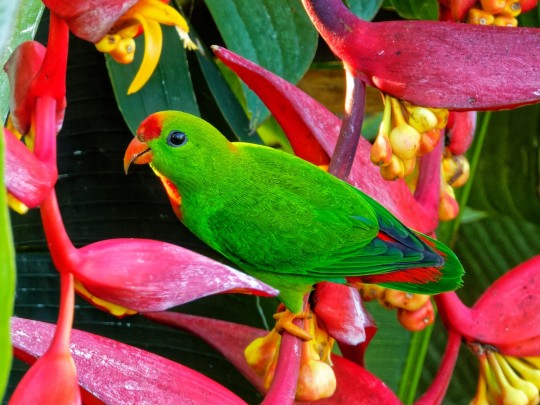
Philippine Hanging Parrot (Loriculus philippensis)
© Ravi Iyengar
184 notes
·
View notes
Text

March 25, 2022 - Philippine Hanging Parrot or Colasisi (Loriculus philippensis)
Found in the Philippines, these tiny parrots live in lowland and foothill forests. They eat coconut blossoms, nectar, figs and other fruits, and seeds, foraging acrobatically in flowering trees, alone, in pairs, or in small flocks. Breeding from March through May or September through November, they nest in cavities in trees.
#philippine hanging parrot#parrot#loriculus philippensis#bird#birds#illustration#art#tropical#birblr art
57 notes
·
View notes
Photo

A new variant has been added!
Philippine Hanging Parrot (Loriculus philippensis) © John Gerrard Keulemans
It hatches from bluish, bodied, female, green, large, long, male, orange, overall, red, similar, small, upper, variable, and wooded eggs.
squawkoverflow - the ultimate bird collecting game 🥚 hatch ❤️ collect 🤝 connect
0 notes
Photo
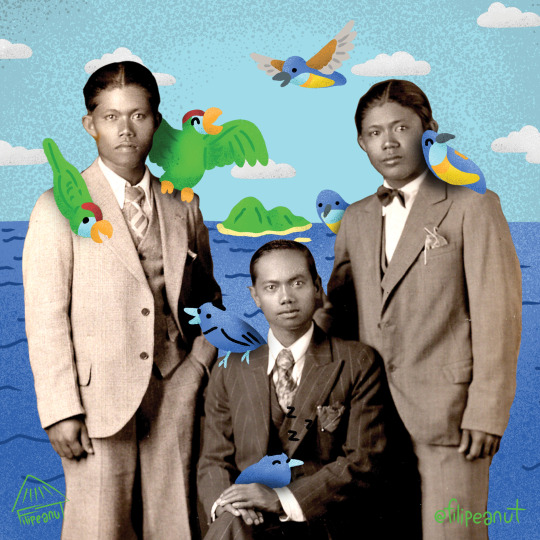
Here is Albert Balbutin Sr., Ernie Balbutin, and Delphin Balbutin, left to right. Their vibrant and classy suits, as Mina Roces put it, “transformed them from lower-class agricultural laborer or Alaskan cannery worker to fashionable dandy and temporarily erased the stigma of manual labor.” After the US colonized the Philippines at the turn of the 20th century, around 150,000 Filipinos, mostly men, immigrated to the US for work. Around the same time, 122 million board feet of Philippine lumber and timber was exported from the Philippines to the US and other countries. Forests in the Philippines dwindled from 70% forest cover at the start of US colonization, to almost half forest cover by 1932. Illustrated in the graphic are the remaining birds living in Camiguin, some endemic or only found there. Many known for their beautiful plumage.
Immigration info: SAGE Enyclopedia of Filipina/x/o American Studies. Roces 2016.
Forest info: Ponce 1939, Bankoff 2007.
Birds: Camiguin Hanging-Parrot, Black-naped Monarch, Orange-bellied Flowerpecker (all subspecies endemic to Camiguin).
8 notes
·
View notes
Text

Let’s hang out with Colasisi or Kulasisi! Also known as the Philippine hanging parrot, they are often observed hanging upside down, especially during courtship when the male (left) will approach a female (right) to woo her.
They are beautiful birds, with slight variations in color depending on the sub-species in different areas and islands.
Artprint: https://society6.com/product/colasisi-or-philippine-hanging-parrot-loriculus-philippensis_mini-art-print
Tote: https://www.redbubble.com/i/tote-bag/Colasisi-or-Philippine-Hanging-Parrot-Loriculus-philippensis-by-Filipeanut/115942159.A9G4R?asc=u
17 notes
·
View notes
Photo

Philippine Hanging-parrot (Loriculus philippensis) by Thanks for 3 million views Also known as Colasisi. This is the subspecies "regulus", male with a golden crown. Only found on a few islands in central Philippines. Baslay, Negros Island, Philippines. Photo taken by my wife Anna. https://flic.kr/p/2iGD6Fx
2 notes
·
View notes
Text
Loriculus

Sri-Lankan Hanging Parrot by Hafiz Issadeen, CC BY 2.0
Etymology: Lory
First Described By: Blythe, 1849
Classification: Dinosauromorpha, Dinosauriformes, Dracohors, Dinosauria, Saurischia, Eusaurischia, Theropoda, Neotheropoda, Averostra, Tetanurae, Orionides, Avetheropoda, Coelurosauria, Tyrannoraptora, Maniraptoromorpha, Maniraptoriformes, Maniraptora, Pennaraptora, Paraves, Eumaniraptora, Averaptora, Avialae, Euavialae, Avebrevicauda, Pygostaylia, Ornithothoraces, Euornithes, Ornithuromorpha, Ornithurae, Neornithes, Neognathae, Neoaves, Inopinaves, Telluraves, Australaves, Eufalconimorphae, Psittacopasserae, Psittaciformes, Psittacoidea, Psittaculidae, Agapornithinae
Referred Species: L. amabilis (Moluccan Hanging Parrot), L. aurantiiforns (Orange-Fronted Hanging Parrot), L. beryllinus (Sri Lanka Hanging Parrot), L. catamene (Sangihe Hanging Parrot), L. camiguinensis (Camiguin Hanging Parrot), L. exilis (Pygmy Hanging Parrot), L. flosculus (Wallace’s Hanging Parrot), L. galgulus (Blue-Crowned Hanging Parrot), L. philippensis (Philippine Hanging Parrot), L. pusillus (Yellow-Throated Hanging Parrot, L. sclateri (Sula Hanging Parrot), L. stigmatus (Great Hanging Parrot), L. tener (Bismarck Hanging Parrot), L. vernalis (Vernal Hanging Parrot)
Status: Extant, Endangered - Least Concern
Time and Place: Within the last 10,000 years, in the Holocene of the Quaternary


The Hanging Parrots are known entirely from Southeast Asia and the Pacific Islands
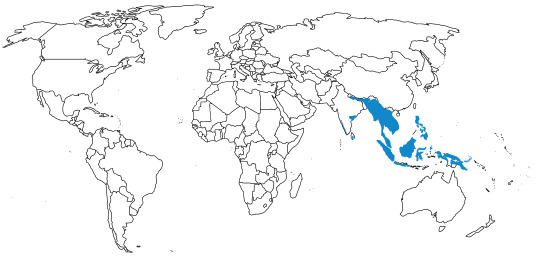
Physical Description: The Hanging Parrots are small, green parrots, ranging from 10 to 15 centimeters in length - essentially the same size as their close relatives, the Lovebirds. As parrots, they have small bodies, short tails, feet with two toes pointing forward and two backward, big heads, and strongly curved beaks. Also, as parrots, they are very intelligent and social creatures. These birds are green in general, with a variety of different patches of color on their heads, wings, and tails to distinguish them and look fancy for other hanging parrots. These colors are usually reds, oranges, and yellows; though at least a few have blue patches as well. These birds are usually sexually dimorphic, with the females having fewer patches of bright color than the males.
Diet: Flowers, fruits, nectar, and seeds from a variety of tropical trees.
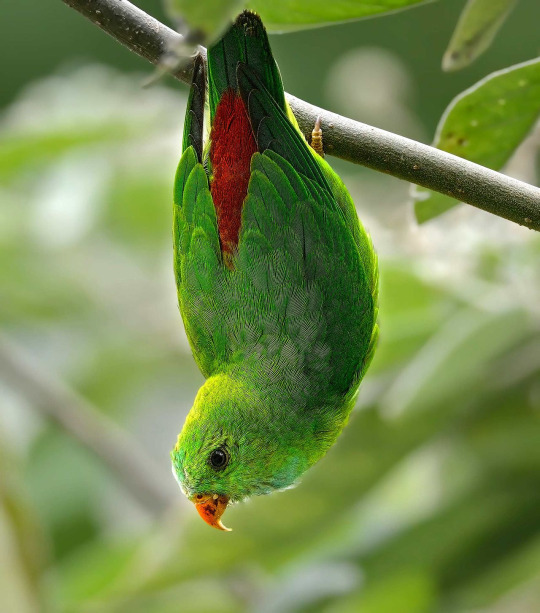
Vernal Hanging Parrot by Raj Dhage, CC BY-SA 4.0
Behavior: These birds are notable from the fact that they hang down in trees and from other high surfaces, often upside down, to reach sources of food in the trees. They are also unique amongst parrots in not only foraging upside down, but also sleeping upside down - they’ll hang, more passively, from branches in order to sleep. This gives them a rather fruity look themselves - like they’re ripe for the harvest, and it’s perfectly adorable. These parrots range from being very social - living in large flocks - to being almost solitary, only ever foraging in pairs during the breeding season and alone during the off season. Very few of these birds will ever go back to the ground, but rather spend all of their time in trees.
These birds make a wide variety of calls, such as tzeet-tzeet-tzeet, squeaky warbles, and twitters. Overall, however, they’re not quite as vocal as other kinds of parrot. Though no species undertakes large-scale migrations, they are somewhat nomadic, moving from tree to tree in search of food, and sometimes going up and down mountains based on food availability.
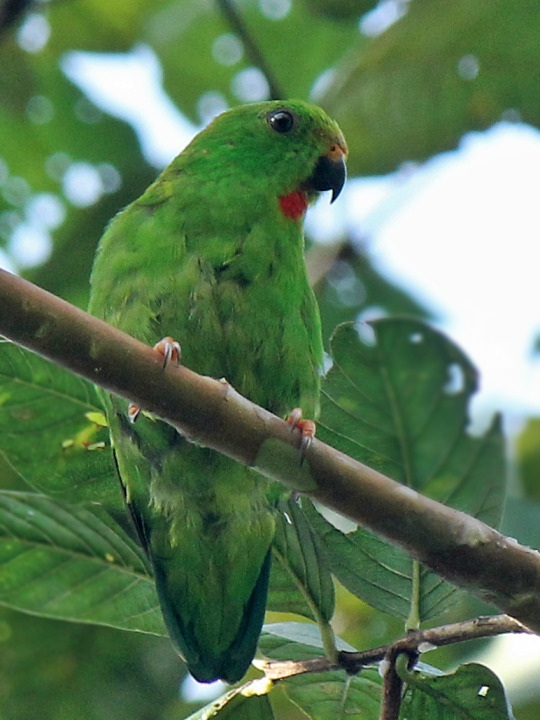
Sulawesi Hanging Parrot by A.S. Kono, CC BY-SA 3.0
The Hanging Parrots generally begin breeding all throughout the year, based on the species - some will start their breeding season in September, others in January, and so on. It really depend son the parrot. They’ll place their nests in holes of bamboo and in tree trunks, anywhere they can keep it relatively high off of the ground. They usually lay only two eggs per breeding season, though at least a few species will lay up to three. They incubate the eggs for about three weeks, and the nestlings stay in the nest for five weeks.
Ecosystem: The Hanging Parrots live in tropical rainforest, throughout the forest itself - some species will be found in denser forests, others in the secondary growth, others at the edge, as well as in peatswamps, near rivers, in patches of bamboo, and mangrove forests. They usually live at lower elevations, though some will migrate to higher parts of the mountains in search of food. They rarely come down from the trees, and spend most of their time at least a few meters off of the ground. Some are also found in tropical dry forests.
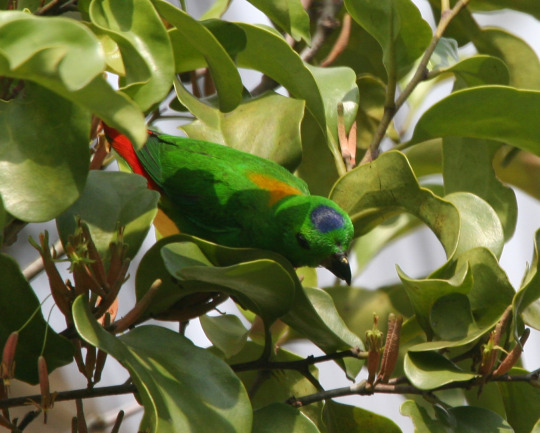
Blue Crowned Hanging Parrot by Kee Yap, CC BY-SA 2.0
Other: These birds are mostly conservationally doing alright, except for some endangerment due to habitat loss. As rainforests and other tropical forests fragment, the Hanging Parrots lose range and ability to contact other parrots, making their populations more vulnerable. Still, only a few species have shown a marked decline in population. At least one parrot, the Camiguin Hanging-Parrot, is rarely ever found. These birds are not good pet parrots, given a wide number of requirements in captivity; however, they are still subject to the illegal pet trade, much to the chagrin of their vulnerable populations.
Species Differences: The Moluccan Hanging-Parrot has a bright red cap on its head and a bright red tail; it mainly lives on the island of Maluku. The Orange-Fronted Hanging Parrot has the same patterns as the Moluccan Hanging Parrot, except it is orange instead of red; it starts breeding in September, and lives in New Guinea. The Sri Lankan Hanging Parrot has an orange top of the head, brown back, and a blue patch on the throat; it begins breeding in January, and lives mainly in Sri Lanka. The Sangihe Hanging Parrot looks very similar to the Moluccan Hanging Parrot, but instead lives in Sulawesi and is a more yellowish green. The Camiguin hanging Parrot is a lighter green, with a light blue patch on its face; it breeds in September, and is known only from the island of Camiguin. The Pygmy Hanging Parrot is the smallest of them all, and only has a red patch on its neck; they breed in February, and live in Sulawesi.

Sri Lanka Hanging Parrot by Thimindu, CC BY-SA 3.0
The Flores Hanging Parrot has red patches on its back, and lives in Java. The Blue-Crowned Hanging Parrot has a distinctive blue patch on its head; it starts breeding in January, and lives throughout Indonesia and Southeast Asia. The Philippine Hanging Parrot has green and yellow orange patches all over, lives in the Philippines, and breeds in March or September. The Yellow-Throated Hanging Parrot has a bright yellow patch on its throat, breeds in April, and lives in Java. The Sula Hanging Parrot has an orange back and lives in Sulawesi. The Sulawesi Hanging Parrot is a lighter green with a brown back, and a red head patch; it breeds in January and April, and lives in Sulawesi. The Bismark Hanging Parrot is a more yellow green with a small red patch on its throat, and lives on the island of New Britain. Finally, the Vernal Hanging Parrot has a light blue throat patch, breeds in January, and lives throughout Southeast Asia and in some patches of the Indian Subcontinent.
~ By Meig Dickson
Sources under the Cut
Collar, N. & Kirwan, G.M. (2019). Bismarck Hanging-parrot (Loriculus tener). In: del Hoyo, J., Elliott, A., Sargatal, J., Christie, D.A. & de Juana, E. (eds.). Handbook of the Birds of the World Alive. Lynx Edicions, Barcelona.
Collar, N. & Boesman, P. (2019). Blue-crowned Hanging-parrot (Loriculus galgulus). In: del Hoyo, J., Elliott, A., Sargatal, J., Christie, D.A. & de Juana, E. (eds.). Handbook of the Birds of the World Alive. Lynx Edicions, Barcelona.
Collar, N., de Juana, E. & Boesman, P. (2019). Flores Hanging-parrot (Loriculus flosculus). In: del Hoyo, J., Elliott, A., Sargatal, J., Christie, D.A. & de Juana, E. (eds.). Handbook of the Birds of the World Alive. Lynx Edicions, Barcelona.
Collar, N. & Boesman, P. (2019). Moluccan Hanging-parrot (Loriculus amabilis). In: del Hoyo, J., Elliott, A., Sargatal, J., Christie, D.A. & de Juana, E. (eds.). Handbook of the Birds of the World Alive. Lynx Edicions, Barcelona.
Collar, N. & Boesman, P. (2019). Orange-fronted Hanging-parrot (Loriculus aurantiifrons). In: del Hoyo, J., Elliott, A., Sargatal, J., Christie, D.A. & de Juana, E. (eds.). Handbook of the Birds of the World Alive. Lynx Edicions, Barcelona.
Collar, N. & Kirwan, G.M. (2019). Philippine Hanging-parrot (Loriculus philippensis). In: del Hoyo, J., Elliott, A., Sargatal, J., Christie, D.A. & de Juana, E. (eds.). Handbook of the Birds of the World Alive. Lynx Edicions, Barcelona.
Collar, N., Kirwan, G.M. & Boesman, P. (2019). Pygmy Hanging-parrot (Loriculus exilis). In: del Hoyo, J., Elliott, A., Sargatal, J., Christie, D.A. & de Juana, E. (eds.). Handbook of the Birds of the World Alive. Lynx Edicions, Barcelona.
Collar, N., Sharpe, C.J. & Boesman, P. (2019). Sangihe Hanging-parrot (Loriculus catamene). In: del Hoyo, J., Elliott, A., Sargatal, J., Christie, D.A. & de Juana, E. (eds.). Handbook of the Birds of the World Alive. Lynx Edicions, Barcelona.
Collar, N. & Boesman, P. (2019). Sri Lanka Hanging-parrot (Loriculus beryllinus). In: del Hoyo, J., Elliott, A., Sargatal, J., Christie, D.A. & de Juana, E. (eds.). Handbook of the Birds of the World Alive. Lynx Edicions, Barcelona.
Collar, N. & Boesman, P. (2019). Sula Hanging-parrot (Loriculus sclateri). In: del Hoyo, J., Elliott, A., Sargatal, J., Christie, D.A. & de Juana, E. (eds.). Handbook of the Birds of the World Alive. Lynx Edicions, Barcelona.
Collar, N. & Boesman, P. (2019). Sulawesi Hanging-parrot (Loriculus stigmatus). In: del Hoyo, J., Elliott, A., Sargatal, J., Christie, D.A. & de Juana, E. (eds.). Handbook of the Birds of the World Alive. Lynx Edicions, Barcelona.
Collar, N. & Boesman, P. (2019). Vernal Hanging-parrot (Loriculus vernalis). In: del Hoyo, J., Elliott, A., Sargatal, J., Christie, D.A. & de Juana, E. (eds.). Handbook of the Birds of the World Alive. Lynx Edicions, Barcelona.
Collar, N. & Boesman, P. (2019). Yellow-throated Hanging-parrot (Loriculus pusillus). In: del Hoyo, J., Elliott, A., Sargatal, J., Christie, D.A. & de Juana, E. (eds.). Handbook of the Birds of the World Alive. Lynx Edicions, Barcelona.
Fjeldså, J. (2019). Camiguin Hanging-parrot (Loriculus camiguinensis). In: del Hoyo, J., Elliott, A., Sargatal, J., Christie, D.A. & de Juana, E. (eds.). Handbook of the Birds of the World Alive. Lynx Edicions, Barcelona.
Jobling, J. A. 2010. The Helm Dictionary of Scientific Bird Names. Christopher Helm Publishing, A&C Black Publishers Ltd, London.
#loriculus#hanging parrot#parrot#bird#dinosaur#birblr#factfile#australavian#quaternary#Australia and Oceania#Eurasia#Flying Friday#Herbivore#dinosaurs#biology#a dinosaur a day#a-dinosaur-a-day#dinosaur of the day#dinosaur-of-the-day#science#nature
163 notes
·
View notes
Text







and that concludes my 7 days of sketching mostly parrots all from the Philippines! Already posted separately but I'm happy I managed to stick to it throughout my encounter with covid so here they are all together. I hadn't really tried Neocolor II and markers before and I think there was some progress: though I'm really fond of the Guaiaberos I did the first day.
from left to right, top to bottom: flame-breasted fruit dove, blue-naped parrot, red-vented cockatoo, mindanao lorikeets, blue-headed racket-tail, guaiabero, philippine hanging parrot. The bottom ones are the earliest attempts, as you might guess!
#illustration#birds#anyway the philippines have so many beautiful birds and it was fun to learn about them#artists on tumblr#birbfest2023
50 notes
·
View notes
Photo

The intro day for my participation in the drawing challenge #Mumuktubre by Shibikii over at DeviantART, drawing a different mythical monster from the Philippines for each day of October! As someone with Filipino roots who LOVES mythical monsters, I couldn't resist the temptation! I actually drew all of them in advance because I know I wouldn't have the time and energy to draw them normally in this kind of art challenge, but it was still fun! Sadly, my favorite monster from the Philippines wasn't included, so I decided I might as well include it myself as an introduction! This is the Alan, a deformed creature with wings whose hands and feet point backwards and sleeps by hanging upside-down from branches. Alans have a fondness for children, usually taking in lost children and raising them as their own, but also sometimes stealing reproductive waste from women while they sleep and magically transforming them into babies who they raise as their own. Yeah...a lot of monsters in the Philippines are pretty weird.
Alans are also said to be trickster-ish in terms of behavior, adding to a long list of mythical winged trickster creatures in myths and legends around the world--the harpies and sirens of Greece, the tengu of Japan and now the alan of the Philippines--with one of their most famous myths being one of a man who stumbled upon a group of alans sleeping in the trees above him. He panicked, fearing that these strange creatures would eat him if they woke up, and fled, only to trip and fall on his face. The alans awoke and immediately wept for the man, fearing that he had died, before flying down and "honoring" him by covering him with gold and beads. He responded by yelling at them to get away from him. They were saddened, but willing to let him go and even keep the (no doubt extremely valuable) beads as long as he gave one--the bead nagaba, which had a peculiar effect--back to them. He refused and the alans began to cry as they flew off and called out "We're going to burn your house down, because you're a bad man!"
Sure enough, when he returned home, his house was nothing but ashes.
And that's what happens when you insult your friendly flying trickster spirits.
There's another, less comical story about an alan in which a pair of hunters manage to kill a pig, but have no fire to cook it with. They search for a potential source and find a mother alan and her baby in a large house in a tree. The alan was willing to give them some fire and even help them cook the pig, on one condition: One of the hunters has to feed the pig's liver to her baby. The hunter, however, stupidly ATE the liver on the way to take it to the baby and, in an even STUPIDER move, he decides the best way to deal with the hungry baby is to...throw it into the cauldron of boiling water the mother left.
Yeah. He's not a very smart hunter is he?
So when he gets back he lies to the alan and claims that the baby ate well, but then she flies home and discovers her baby, dead and presumably cooked to perfection, and is justifiably and rightfully pissed! So she immediately goes after the two idiots who did this and finds them in a tree. She can't reach them (the story doesn't explain why she doesn't just fly up there) and asks how they got up there. They claim that they climbed up feet first and so, when she does so to catch them, they cut the vine she's climbing and she...plummets to her death. And then the hunters ransack her house and return home with plenty of gold and beads.
...That's a TERRIBLE ending! Those MONSTERS got away with killing that poor creature's baby, after one of them selfishly coveted food that was meant for said baby, and THEN killed the grieving mother when she had every right to want to kill them for murdering her child--and then on top of that, they STEAL FROM HER and presumably get rich out of it!? That breaks my heart! Hopefully some other alans managed to obtain some justice for their fallen sister.
Sadly, this is apparently a popular trend with the less powerful spirits of Filipino mythology--they're often mocked, ridiculed and given the short end of the stick. But fortunately, as seen with the first tale, they're just as often given a chance at revenge.
On a less sad note, the alan should probably have batlike wings or something, but when I first heard of them they were described as looking like deformed bird-people. I'll probably experiment with more batlike alans in future artwork (I feel the need to point out that I kiiiiiinda anthropomorphised this one more than I would in other circumstances), but until then, I went for this one being more birdlike and based the colors of his wings and tail off of a Philippine hanging parrot, for reasons that...should be obvious! Sources for both of these stories: www.surlalunefairytales.com/bo…, www.surlalunefairytales.com/bo…
Next up, Mumuktubre will start for REAL with the dreaded Manananggal!
6 notes
·
View notes
Text



Island bird specimens at the Field Museum. From left to right: Camiguin hanging parrot (Loriculus camiguinensis, endemic to the Philippines), velvet asity (Philepitta castanea, endemic to Madagascar), and cryptic warbler (Cryptosylvicola randrianasoloi, also endemic to Madagascar).
16 notes
·
View notes
Text
All about me

Just to clarify, my name is not AJ, I just prefer that name, its like my online name bc I'm not comfortable sharing my real one.
I'm Filipino, I'm from the Philippines and my mom is Filipino, although my dad isn't, he's German, Irish, and Scottish and hes from America that that makes me Filipino, Irish, Scottish, German and American?
My favorite food is pizza, literally any pizza, pizza is pizza 🤩 and rice cakes, ice cream mochi and just normal mochi, rice, fish, chocolate, strawberry, mint, and orange sherbet ice cream, hamburgers, the Filipino chocolate and strawberry wafer sticks, miso soup, teriyaki chicken, Alfredo, pasta, Chinese chicken, lumpia, and halo-halo, I HAVE A BUNCH MORE
My fav color is purple, green, blue, red and black ❤️
My favorite instrument is the violin and the guitar, all types. I actually play the bass guitar! 😜🎸
My hobbies are drawing, (I'm an artist) sleeping, eating, and hanging out with my friends
I am not an only child, I have an older sister
My fav animes are aot, saiki k, violet evergarden, a silent voice, chainsaw man, and alot more that i cant think of
My fav TV shows/series are the Umbrella Academy, Marlon, K-dramas, Sam and cat, and Victorious (I REMEMBER WATCHING THEM ALL THE TIME)
my fav drink is lemon water, grape and the tropical punch kool aid, chocolate milk (ESP THE ONES IN THE PHILLIPINES) cherry coke and normal coke, mountain dew, and many more
My bday is in January, and I was born on 11:11 am, SERIOUSLY IT LITERALLY SAYS THAT ON MY BIRTH CERTIFICATE I CAN SHOW YOU GUYS
My fav animals are foxes, pandas, woolly monkeys, cats and dogs, parrots, and many more. I actually have a story abt a bird, so I was sitting in class and this bird came up to the window, it had blue, red, green, and yellow LIKE A PARROT but it flew away in a few seconds and there are like no parents around where I live but yeah that's cool
My fav sea animal are sting rays, jellyfish, dolphins and sharks
I've been to the Philippines, Cambodia, Japan, I actual went there to Tokyo when I was a baby 😜 Michigan, Florida, New York, Ohio, Pennsylvania, Massachusetts, Chicago, Hong Kong, Vietnam, Canada, and prob like 1-2 more, I forget. But places I wanna go to is France, South Korea, New Mexico, and Vietnam and Japan again. If we get enough money, my family and I are going back to the Philippines for a vacation there to see our family that lives there. We need 7k to go there and to come back where I live rn. 😕
I have 3 cats
My style is sometimes skater girl, dark academia, cottage core, or really just anything comfy but it still looks nice yk
I have black hair
My eye color is brown, it looks so pretty in the sun 🤩 I've actually been getting so many stuff in my eye lately, I got 4 eyelashes in my eyes yesterday, and shampoo while taking and shower and it stung so bad, I've been getting eyelashes in my eye nonstop for so long. OMG OFJDKF so yesterday I had an eyelash in my eye after my guitar practice, so I tried getting it to the corner of my eye, like the corner near my nose, and it was a small eyelash. And yk your teardrop holes in the corner... you prob already guessed it.... IT GOT STUCK IN THERE. So when it was in the corner it kinda when near my upper eyelid and I blinked THEN I SAW THE TIP OF THE EYELASH IN THE TEARDROP HOLE 😕✌️ IT SCARED ME SO BAD I ALMOST HAD A HEART ATTACK I LITERALLY DID 😭 but I got it out
I have really weird dream
I'm an insomniac, I have every problem that you could think of my life's a mess 😭
I'm broke
really really dirty minded 😜✌️
A/N: I'm getting kinda tired so I might make a part 2 of this? Lmk what questions abt me I should answer if any of you have some. Anyway, have a good night/day <33

1 note
·
View note